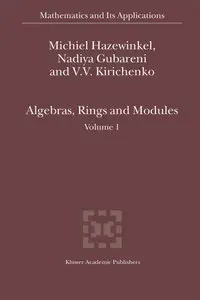Michiel Hazewinkel, Nadiya Gubareni, V. V. Kirichenko, "Algebras, Rings and Modules: Volume 1"
2004 | pages: 393 | ISBN: 1402026900 | PDF | 1,9 mb
2004 | pages: 393 | ISBN: 1402026900 | PDF | 1,9 mb
Accosiative rings and algebras are very interesting algebraic structures. In a strict sense, the theory of algebras (in particular, noncommutative algebras) originated from a single example, namely the quaternions, created by Sir William R. Hamilton in 1843. This was the first example of a noncommutative ”number system”. During the next forty years mathematicians introduced other examples of noncommutative algebras, began to bring some order into them and to single out certain types of algebras for special attention. Thus, low-dimensional algebras, division algebras, and commutative algebras, were classified and characterized. The first complete results in the structure theory of associative algebras over the real and complex fields were obtained by T.Molien, E.Cartan and G.Frobenius.
Modern ring theory began when J.H.Wedderburn proved his celebrated clas-sification theorem for finite dimensional semisimple algebras over arbitrary fields. Twenty years later, E.Artin proved a structure theorem for rings satisfying both the ascending and descending chain condition which generalized Wedderburn structure theorem. The Wedderburn-Artin theorem has since become a corner-stone of noncommutative ring theory.
My Links



